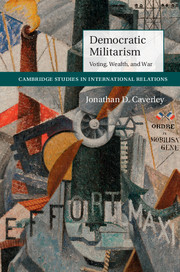Book contents
- Frontmatter
- Dedication
- Contents
- List of figures
- List of tables
- Acknowledgments
- 1 Introduction: sources of democratic military aggression
- 2 Cost distribution and aggressive grand strategy
- 3 Analyses of public opinion
- 4 Analyses of arming and war
- 5 British electoral reform and imperial overstretch
- 6 Vietnam and the American way of small war
- 7 Becoming a normal democracy: Israel
- 8 Conclusion: strategy wears a dollar sign
- Bibliography
- Index
8 - Conclusion: strategy wears a dollar sign
Published online by Cambridge University Press: 05 July 2014
- Frontmatter
- Dedication
- Contents
- List of figures
- List of tables
- Acknowledgments
- 1 Introduction: sources of democratic military aggression
- 2 Cost distribution and aggressive grand strategy
- 3 Analyses of public opinion
- 4 Analyses of arming and war
- 5 British electoral reform and imperial overstretch
- 6 Vietnam and the American way of small war
- 7 Becoming a normal democracy: Israel
- 8 Conclusion: strategy wears a dollar sign
- Bibliography
- Index
Summary
War is horror. Small wars, no matter how capitalized, involve death as well as taxes. But the balance of these costs matters greatly to war's initiation and conduct. American forces in Vietnam, which I presented as a model of capital-intensive small warfare, nonetheless sustained over 47,000 combat fatalities. North Vietnam and the Viet Cong lost roughly the same number during the Tet Offensive alone. Approximately a million Vietnamese (many civilians) died in the war. As of early 2013, in Iraq and Afghanistan, the United States suffered 5,242 persons “killed in action.” Then again, the Soviets lost 13,310 only in Afghanistan (Taubman, 1988). One relatively conservative estimate places Afghan, Iraqi, and Pakistani civilian deaths in excess of 150,000 (Crawford, 2011). The relative lack of casualties for the third-party force is one of the reasons making these wars possible in the first place, and helps explain why these conflicts have lasted so long. After World War II, George Marshall famously observed that “a democracy cannot fight a Seven Years' War,” but the experience of the United States (and its allies) in Vietnam, Iraq, and Afghanistan suggests otherwise.
The copious use of capital in the pursuit of small marginal gains typifies the democratic way of war. British soldiers refer to firing a Javelin, a shoulder-fired anti-tank missile that has been used over 2,000 times in the largely tank-free environments of Afghanistan and Iraq, as “throwing a Porsche” due to its expense (Jacob and Benzkofer, 2012).
- Type
- Chapter
- Information
- Democratic MilitarismVoting, Wealth, and War, pp. 254 - 272Publisher: Cambridge University PressPrint publication year: 2014



